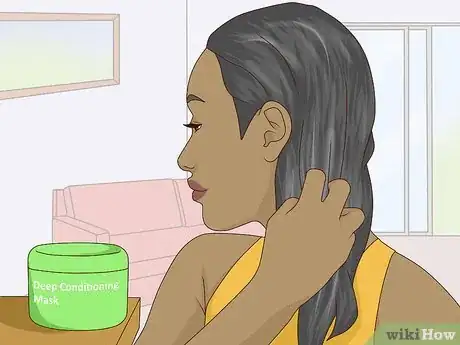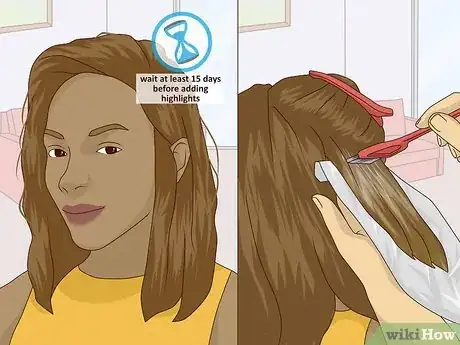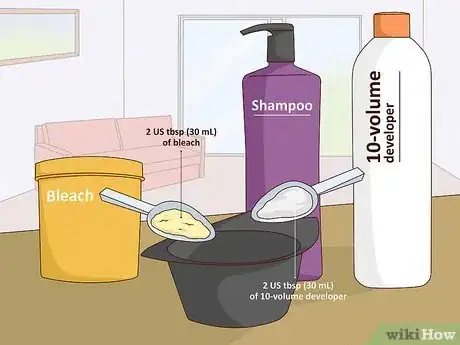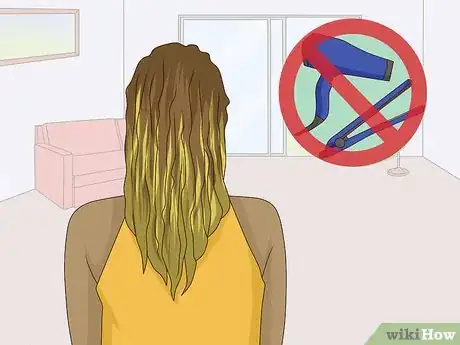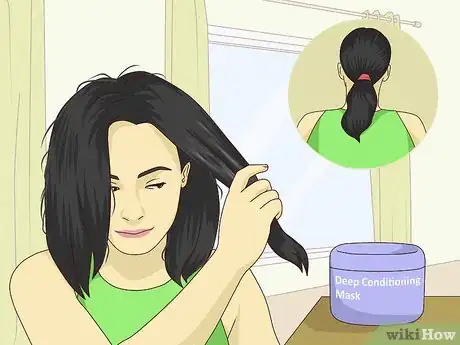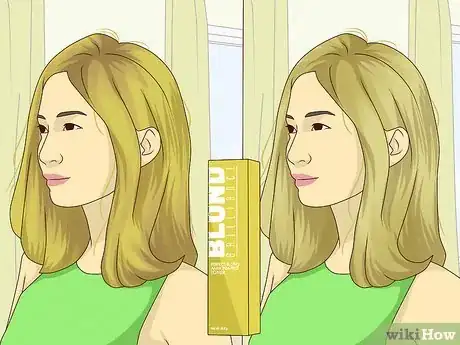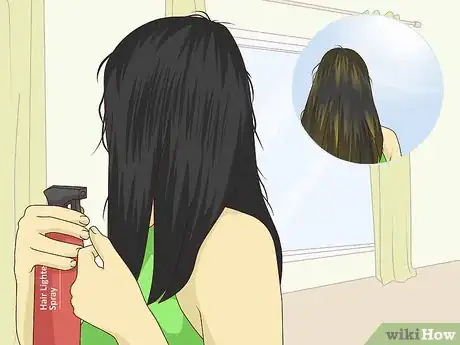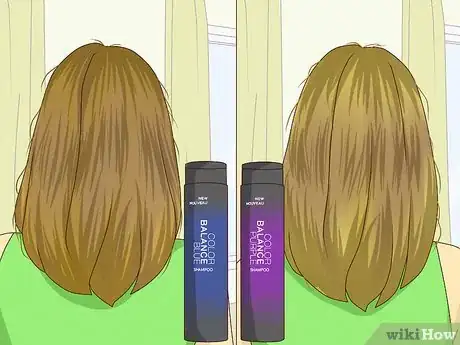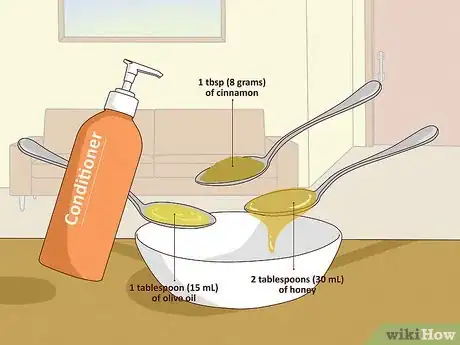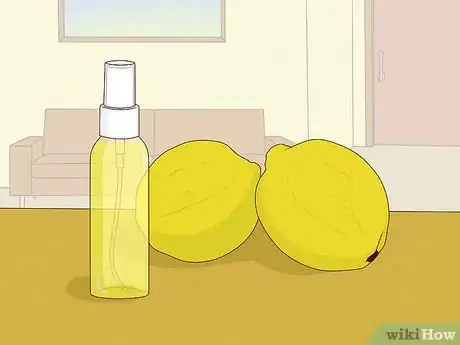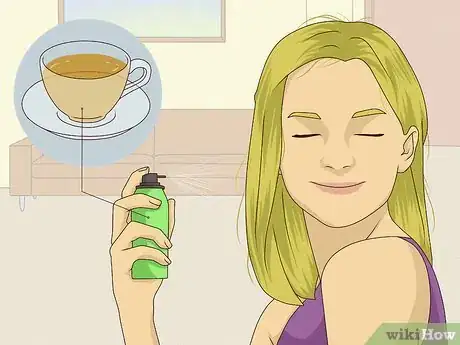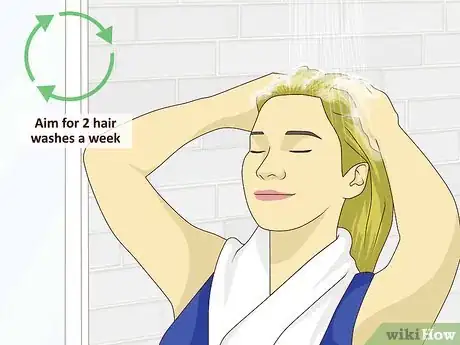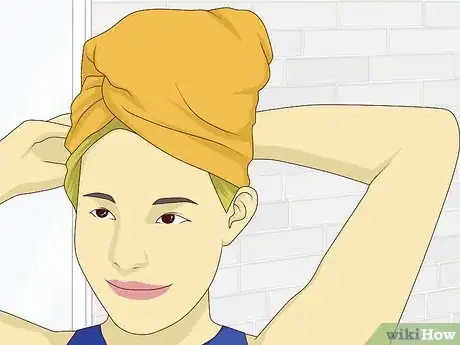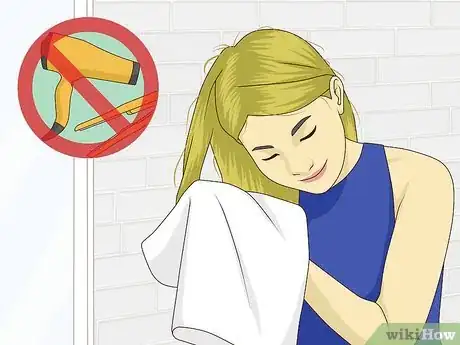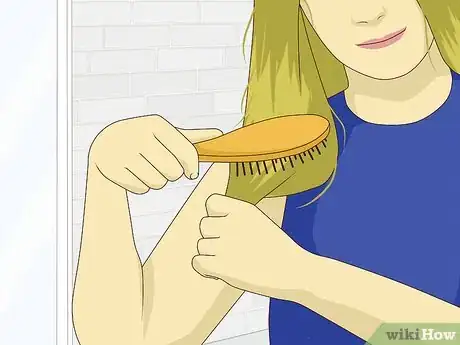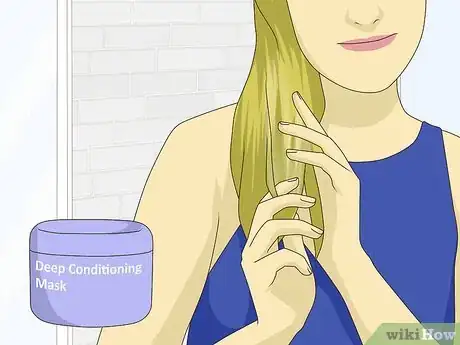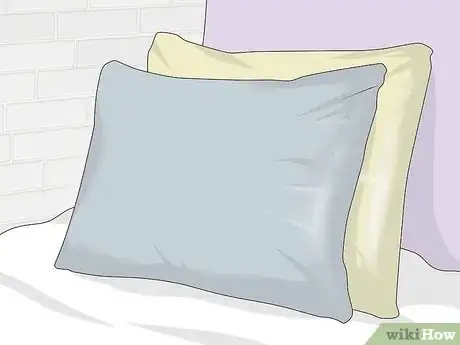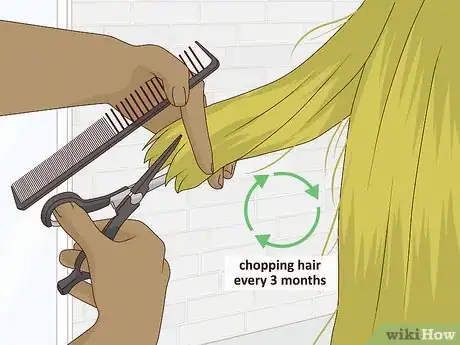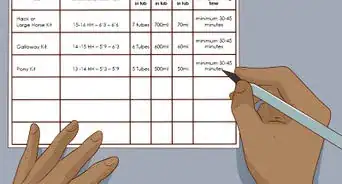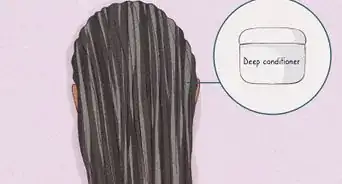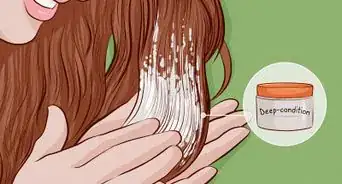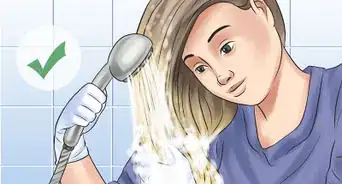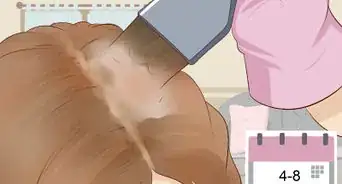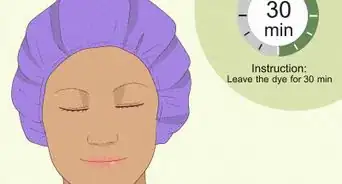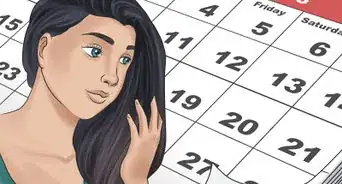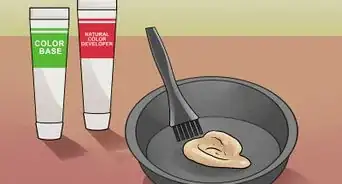This article was co-authored by Charlie Adams. Charlie Adams is a Professional Hair Stylist, Board Certified Haircolorist, and the Founder of Salon XL based in Ann Arbor, Michigan. With over two decades of experience, Charlie specializes in innovative styling and texturizing techniques as well as hair coloring. Charlie and Salon XL have received awards from ELLE Magazine’s Top 100 Salon "Best Hair in America" and "Best Color Salons,” StyleLine’s "Top Shop" in Michigan, Hour Magazine’s "Best of Detroit" and "Best Hair Salon in Ann Arbor,” Harper's Bazaar’s "Best of the Midwest," Allure Magazine’s "The A List," and Process Magazine’s "The Best Color.” Salon XL is also a member of Intercoiffure, a prestigious salon organization.
There are 18 references cited in this article, which can be found at the bottom of the page.
This article has been viewed 10,966 times.
When that urge to lighten your hair hits, it’s incredibly hard to resist! Even if your hair is already damaged, you might be toying with the idea of getting your locks a few shades lighter and wondering how to do it safely. If possible, wait a few months and ply your hair with TLC to get it as healthy as possible before doing anything. But if you’re determined to proceed right now, you have a few options to choose from. If you want to quickly lighten your entire head of hair or want to go from dark to blonde, check out the bleaching options. For a gentler option, use a toner. If you're interested in at-home DIY methods, try a natural lightener.
Steps
Bleaching Options
-
1Spend 1-2 weeks conditioning your hair before applying any bleach. Since your hair is already damaged, waiting a few weeks (or as long as you possibly can) before doing anything involving chemicals will keep your hair as healthy as possible. Before highlighting, bleaching, or doing any other process, spend at least 1 week doing daily deep-conditioning masks. Leave the mask on for at least 30 minutes, or pop on a shower cap and let it saturate your locks overnight.[1]
- Look for products that claim to repair and strengthen damaged hair.
- If you don’t want to buy a special product, using organic coconut oil as a mask will drastically condition your hair and protect it from harsh chemicals.
- You could also look into bond multiplying products like Olaplex, which help build up your hair. Visit a professional salon for help with this.[2]
-
2Add gentle highlights or balayage to lighten parts of your hair. If you recently dyed or bleached your hair, wait at least 15 days before adding highlights. This method is a smart option if you want lighter color but fear damaging your hair with bleach or all-over dye.[3]
- Buy highlighting or balayage kits at your local beauty store.
- As a general rule, aim for a shade that’s 3 steps lighter than the rest of your hair.
- While you can do highlights and balayage at home, consider working with a professional colorist. They’ll have the best shot at coloring your hair without damaging it more.
Advertisement -
3Apply a bleach bath for a gentler alternative to a straight bleach job. Wet your hair and apply a mixture of 1 US tbsp (15 mL) of bleach, 2 US tbsp (30 mL) of 10-volume developer, and enough shampoo to lather all your locks. Put a shower cap over your hair, and set a timer for 5 minutes. After 5 minutes, check your hair—if the color is light enough, go ahead and wash and condition your hair. If it’s not light enough, set a timer for another 5 minutes.[4]
- At the most, leave the bleach bath on your hair for a total of 20 minutes to minimize damage.
- For extra hydration, add 1 tablespoon (15 mL) of conditioner to the mix.[5]
- Wear old clothes and gloves whenever you work with bleach.
-
4Bleach your locks if you want to go from dark hair to blonde hair. You can also bleach your hair if your locks are a lighter shade, but if you have black or very dark brown hair, bleaching is one of the only options to get blonde hair. Bleach is really damaging, so plan on investing a lot of time into gentle and conditioning aftercare.[6]
- If your hair is damaged, bleaching it is one of the worst things you can do—most professional colorists would advise you to wait! But if you need lighter locks and think this is your best option, spend at least a month on conditioning and healing your hair first, especially if your hair was bleached or dyed recently.
- Once the bleach is on your hair, check it every five minutes until it’s light enough for you. Don’t leave it on for longer than 20-30 minutes, tops.
- Both before and after bleaching, stay away from heated styling tools and give your hair tons of TLC. Use hair masks and leave-in conditioners, and only wash your hair 2-3 times a week.
Toners
-
1Set aside a few weeks to condition and heal your hair before treating it. Patience is vital when dealing with already-damaged hair. Though you might be chomping at the bit to lighten your locks, commit to at least 1 week of deep-conditioning treatments. If possible, wait several weeks before toning your hair.[7]
- While you wait, put your hair in a ponytail or braids. Or, cover up with a hat, headband, or fun scarf.
-
2Brighten already-blonde hair with an ammonia-based toner. Follow the toner's directions to mix the right amount with the developer, apply it to your hair, and let it sit for the recommended amount of time (usually 30 minutes). Always rinse the toner out afterward, and use a deep-conditioning mask for the next few days to give your hair some much-needed hydration.[8]
- Toner, unfortunately, won’t work on brown, black, or red hair.
-
3Spritz a hair-lightening spray on damp locks before getting some sun. This works best for those with medium brown and lighter shades of hair, and it doesn’t work if you can’t get outdoors to let the sunlight react with the spray (so try it out on the weekend and not on a day you're stuck in the office). Before going outside, spray the solution onto individual sections of damp, towel-dried hair, then let it do its thing![9]
- Look for a spray that includes ingredients like honey or aloe, which soften and protect your hair. Also, choose one that is sulfate-free so it’s less drying.
- Always read and follow the instructions to make sure you’re using the product correctly.
- If you have dark brown hair, test the spray on a small patch of hair first. There’s a chance it could turn your hair orange instead of blonde.
- Don’t bleach your hair after using a lightening spray, as it can cause severe damage.
-
4Tone dark hues with purple or blue shampoos and conditioners. Here’s the caveat—these products don’t actually lighten your hair. What they do is tone certain shades so that your true color appears brighter and more even. For yellow shades, use purple products. For orange tones, use blue (or ash) products.[10]
- This only works on hair that has been bleached or colored. It won’t lighten natural hair.
- This is a less abrasive method of lightening your locks because you’re not introducing any bleach or chemicals to your hair.
Natural Lighteners
-
1Mix cinnamon and honey to lighten hair that is already blonde. In a clean bowl, combine 2 tablespoons (30 mL) of honey, 1 tbsp (8 grams) of cinnamon, and 1 tablespoon (15 mL) of olive oil (for hydration). If the mixture is too thick to spread over your hair easily, add some conditioner. Spread the paste over your hair and cover it with a plastic bag or shower cap for at least 4 hours, or overnight if possible. Rinse it out and condition your locks afterward.[11]
- The cinnamon activates small amounts of hydrogen peroxide from the honey and lightens your hair.
-
2Lighten blonde hair and highlights with lemon juice and sun exposure. Fill a clean spray bottle 2/3 full of warm water and 1/3 full of lemon juice (bottled or fresh works just as well). Spray the mixture onto your hair until it’s slightly damp, then head outside to hang in the sun for 30 minutes max.[12]
- Lemon juice dries out your hair, so plan on applying deep-conditioning treatments both before and after.
- This method generally only works for people who have light brown or blonde hair. It won’t lighten black or dark brown hair and may not have much of an effect on red hair.
-
3Spritz your hair with brewed chamomile tea to gently lighten blonde hair. Brew a cup of chamomile tea, let it cool, then pour the contents into a clean spray bottle. Spray it all over your hair until it’s slightly damp, then head outside to get some sun.[13]
- Chamomile isn’t nearly as drying as lemon juice, so you don’t need to worry about rinsing it out after a certain amount of time.
- This method works best for blonde hair, but you can try lightening darker hair by adding henna powder to the tea. Add enough to make a paste, then spread the paste through your hair with a comb. Cover your hair for 30 minutes, then rinse the paste out. The effect can be powerful, so try it out on a small piece of hair before applying it to your whole head.
-
4Use a rhubarb and lemon spray to try and lighten darker shades of hair. This won’t work for everyone, but it is worth a shot! The reaction can sometimes make your hair look orangish, so test the spray on a discreet section of hair first. To make the spray, puree a few pieces of rhubarb. Take a clean spray bottle and fill it with equal parts of water, lemon juice, and rhubarb puree. Spritz your hair until it’s damp, then head outside for about 30 minutes.[14]
- Lemon juice dries out your hair, so apply a deep-conditioning mask both before and after the spray treatment.
Gentle Aftercare Tips
-
1Wait a few days between washes to prevent over-drying your locks. Your natural oils keep your hair hydrated and prevent it from drying out. Aim for 2 washes a week. Depending on your hair type and lifestyle, you might have to tweak this a little, but the general rule is that the longer you can go between washes, the better.[15]
- When you wash, scrub your scalp and leave the rest of your hair alone as much as possible. This method of washing treats oil buildup but doesn’t over-dry the rest of your hair.[16]
-
2Wrap damp hair in a microfiber towel to gently wick away moisture. Forget about rubbing a cotton towel over your head to dry your locks! That only increases damage, breaks your hair, and makes it get super frizzy. Instead, carefully wrap a microfiber towel or turban around your hair and let it dry. This is a much safer, gentler way to dry your hair.[17]
- Microfiber towels and turbans weigh less than their cotton counterparts. This means your neck won’t be bothered by holding up that weight as you get ready and drink your morning coffee.
-
3Dry and style your hair without heat as often as you possibly can. Straighteners, curling irons, and hair dryers make getting ready a cinch, but they also damage your hair and dry it out. Especially when you’re dealing with already-damaged hair and are possibly going to treat it again to get it a little lighter, skipping the heat-styling tools is a must.[18]
- If you do use a heat styling tool, protect your locks with a heat protection spray beforehand.[19]
-
4Use a brush with soft, widely-spaced bristles to prevent breakage. Brittle hair can easily break mid-shaft. Using a softer brush helps prevent that from happening. Avoid brushes that have little balls on the ends of the bristles, as those can catch on your hair.[20]
- When in doubt, a boar-bristled brush is always a good option. The bristles redistribute natural oils, so all of your locks benefit. Plus, this type of brush tames frizz, which might be something you’re dealing with.[21]
-
5Apply a deep-conditioning mask once a week to hydrate your hair.[22] Buy a mask at the store or make one at home. Generally, you’ll put the mask on damp hair. Then, wrap your head in a warm towel—the heat helps those healing ingredients penetrate your hair better. Wait 15-60 minutes, depending on the instructions, then shampoo and rinse.[23]
- Make a quick and easy mask at home with olive oil and coconut oil! Melt 1⁄2 cup (120 mL) of coconut oil, then stir in 1 tablespoon (15 mL) of olive oil. Work the mixture through damp hair, cover it with a shower cap, and hang out for 60 minutes. Wash it out with shampoo and rinse your hair with cool water.[24]
-
6Protect your hair overnight by sleeping on a silk pillowcase. Sounds fancy, right? But silk is a super popular and helpful investment when it comes to taking care of your hair. Instead of catching against the fabric, your hair slides over the silk, decreasing breakage and reducing frizz.[25]
- If you don’t want silk pillowcases, wrap your hair in a silk scarf overnight for the same results.
-
7Get regular trims to continually remove damaged hair as it grows. Not only will regular trims make your hair look better, but they’ll also slowly remove damage. Schedule an appointment with your hairdresser every 3 months, at a minimum.[26]
- If you’re feeling bold, consider chopping off a good chunk of your hair. Getting rid of as much damage as possible gets you a clean slate much sooner than waiting for it to grow out.
References
- ↑ https://www.marieclaire.com/beauty/hair/a28599/how-to-go-platinum-blonde/
- ↑ Charlie Adams. Professional Hair Stylist & Board Certified Haircolorist. Expert Interview. 21 July 2021.
- ↑ https://botoxcapilar.org/en/can-i-highlight-my-hair-after-dyeing-it-brown/
- ↑ https://bellatory.com/hair/How-to-do-a-bleach-wash
- ↑ https://botoxcapilar.org/en/how-to-lighten-hair-using-shampoo-and-developer-mixture/
- ↑ https://botoxcapilar.org/en/how-long-should-you-wait-to-bleach-your-hair-again/
- ↑ https://www.marieclaire.com/beauty/hair/a28599/how-to-go-platinum-blonde/
- ↑ https://bellatory.com/hair/DIY-Hair-What-is-Toner-and-How-Does-it-Work
- ↑ https://www.elitedaily.com/p/the-3-best-hair-lightening-sprays-for-brunettes-16980499
- ↑ https://youtu.be/B_u_NjVLre4?t=223
- ↑ https://www.teenvogue.com/story/how-to-lighten-hair-with-the-sun
- ↑ https://www.glamourmagazine.co.uk/article/lemon-juice-in-hair
- ↑ https://bellatory.com/hair/How-to-lighten-your-hair-naturally-at-home
- ↑ https://bellatory.com/hair/How-to-lighten-your-hair-naturally-at-home
- ↑ https://www.whowhatwear.com/how-to-fix-bleached-hair-damage/slide7
- ↑ https://www.realsimple.com/beauty-fashion/hair/hair-care/how-to-repair-hair
- ↑ https://www.whowhatwear.com/how-to-fix-bleached-hair-damage/slide7
- ↑ https://www.whowhatwear.com/how-to-fix-bleached-hair-damage/slide7
- ↑ https://www.goodhousekeeping.com/beauty/hair/tips/a15884/fix-damaged-hair/
- ↑ https://www.goodhousekeeping.com/beauty/hair/tips/a15884/fix-damaged-hair/
- ↑ https://www.southernliving.com/fashion-beauty/hairstyles/boar-bristle-brush
- ↑ https://botoxcapilar.org/en/how-to-lighten-hair-using-shampoo-and-developer-mixture/
- ↑ https://www.realsimple.com/beauty-fashion/hair/hair-care/how-to-repair-hair
- ↑ https://botoxcapilar.org/en/how-to-lighten-hair-using-shampoo-and-developer-mixture/
- ↑ https://www.whowhatwear.com/how-to-fix-bleached-hair-damage/slide7
- ↑ https://www.realsimple.com/beauty-fashion/hair/hair-care/how-to-repair-hair
- ↑ https://www.realsimple.com/beauty-fashion/hair/hair-care/at-home-hair-dye-mistakes
- ↑ https://www.livinggorgeous.com/how-to-fix-uneven-bleached-hair/
